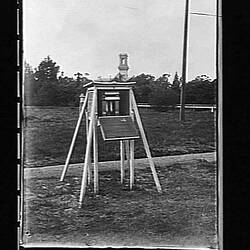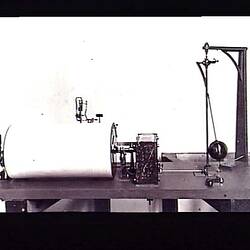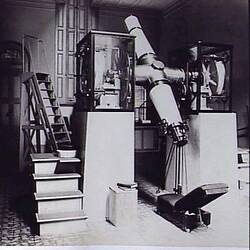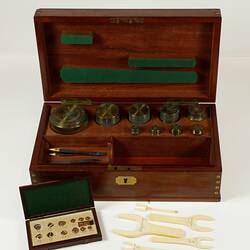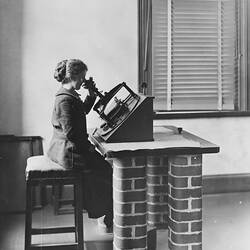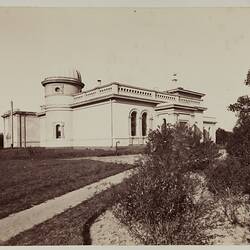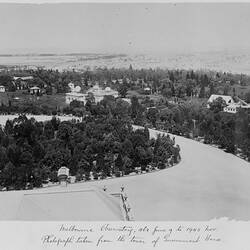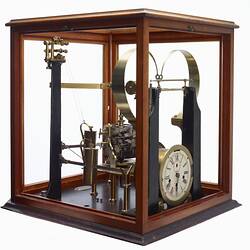Summary
Cathetometer made by Troughton & Simms, London, about 1884. Used at the Melbourne Observatory for precision measurement of small differences in height during the testing of barometers.
Purchased for 30 pounds by Melbourne Observatory in 1884.
Physical Description
Comprises vertical stand on tripod base (with three levelling screws), vertical scale in inches, horizontal telescope (with levelling bubble tube), and scale reading microscope, all supported by puleys and counterweight. Instrument fits into the platform in the base of a wooden carrying box; platform is slide out to remove instrument. Serial number 5213-3. 'The vacuum chamber for testing barometers referred to in my last report has been completed, and proves very satisfactory, both for testing aneroids and mercurial barometers. It consists of a rectangular cast-iron chamber, with thick plate-glass windows at the top, back, and front. This chamber is open at the top, and has a closely fitting cast-iron cover, with indiarubber joint, which can be screwed down and made air-tight. A barometer tube with a calibrated bore and cistern (which is air-tight), is connected with a chamber by a small brass tube with stop-cock. A steel bar, with a fiducial point at bottom, passings through a stuffing-box in the cistern, and can be screwed up or down for contact with the mercury in the cistern; a platinum disc is let in near the top of this bar, with a line engraved at very approximately 30 inches from the fiducial point. The differences between the 30-inch line and the top of the column is read by means of a very fine table cathetometer by Troughton and Simms. The air-pump is very quick in working.' Robert Ellery, Annual Report of the Government Astronomer, 1888, p.6.
More Information
-
Collection Names
-
Collecting Areas
-
Acquisition Information
Donation from Melbourne Observatory, 1994
-
Maker
Troughton & Simms, London, Middlesex, England, Great Britain, circa 1884
-
User
Melbourne Observatory, South Yarra, Greater Melbourne, Victoria, Australia
-
Classification
-
Category
-
Discipline
-
Type of item
-
Overall Dimensions
30 cm (Length), 30 cm (Width), 67 cm (Height)
-
Keywords
Barometer Accessories, Cathetometers, Kathetometers, Physical Apparatus & Instruments

